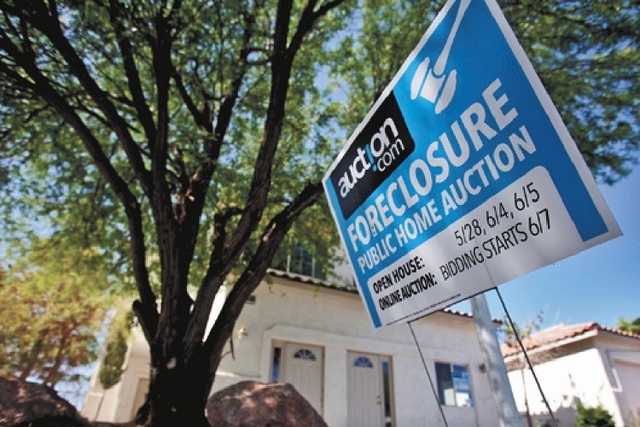Notices of default jump 128 percent in Nevada

Nevada didn’t seem to make much progress improving its housing foreclosure outlook in July.
Wednesday numbers from California research firm RealtyTrac ranked the state No. 3 in the nation for default activity, the latest in a years-long line of appearances in the top five.
Look below the surface, though, and there are signs that banks are poised to begin tackling default inventories — a move that would finally put the state’s housing market on a path to normalcy.
Lenders filed 1,037 notices of default to start foreclosure proceedings in July, up 128 percent from July 2013, RealtyTrac reported. It’s also the highest number of starts since October, when the state’s Homeowners Bill of Rights took effect and put new restrictions on banks looking to foreclose. Monthly foreclosure starts had ranged from 284 to 708 in the first half of 2014 as banks adjusted to the regulations.
It’s important to note that one big month doesn’t make a trend, but RealtyTrac Vice President Daren Blomquist said he believes that banks may finally have figured out how to work under the new law.
“(Notices of default) decreased artificially when the Homeowners Bill of Rights took effect, and those numbers didn’t reflect the true level of distress in the market,” he said. “At some point, that latent distress was going to come through, and July is the earliest indication that has happened.”
Nevada’s foreclosure starts remain well below the 10,000 monthly filings at the peak of the housing crisis in early 2009. They’re also trending below the 4,700 monthly starts before the first state law tightening default rules took effect in October 2011.
But on top of legislative changes, the lower numbers may be coming partly from the fact that there’s just less inventory to foreclose on, Blomquist said. Tens of thousands of Nevada households have already gone through foreclosure. Others have completed short sales for less than what they owed. Some have gotten loan modifications. And Southern Nevada’s negative equity rate has dropped by half, from about 70 percent in 2012 to 35 percent now, as median prices have soared. That lets homeowners sell rather than walk away.
Still, Blomquist estimated a “shadow inventory” of late mortgages on anywhere from 60,000 to 100,000 homes statewide. So it would be years, even at current foreclosure-start rates, before the state cleared its default-based overhang.
That supply isn’t good for the housing market because it creates uncertainty, Blomquist said.
“Nobody knows quite for sure how much distress is left in the market and that still needs to be disposed of. It adds to the level of doubt on what’s behind the curtain. People know those distressed properties, when they actually hit the market for sale, will sell at a discount because of their condition and situation, and that could drag down surrounding property values.”
Nationally, foreclosure starts were down 18.1 percent year over year.
Other states in the top five for overall foreclosure activity were Maryland, Florida, Illinois and Ohio.
Contact reporter Jennifer Robison at jrobison@reviewjournal.com. Follow @J_Robison1 on Twitter.